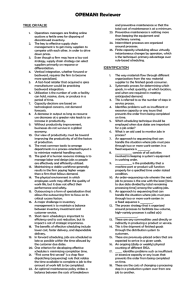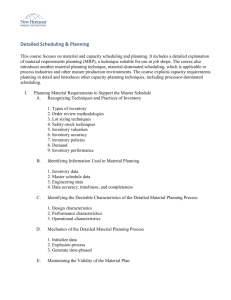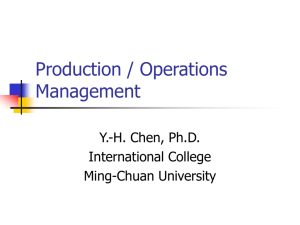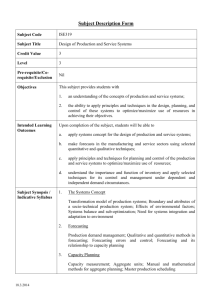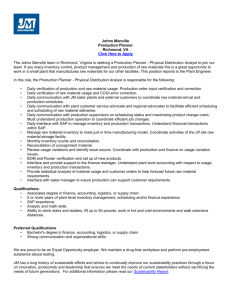Operations Management
advertisement
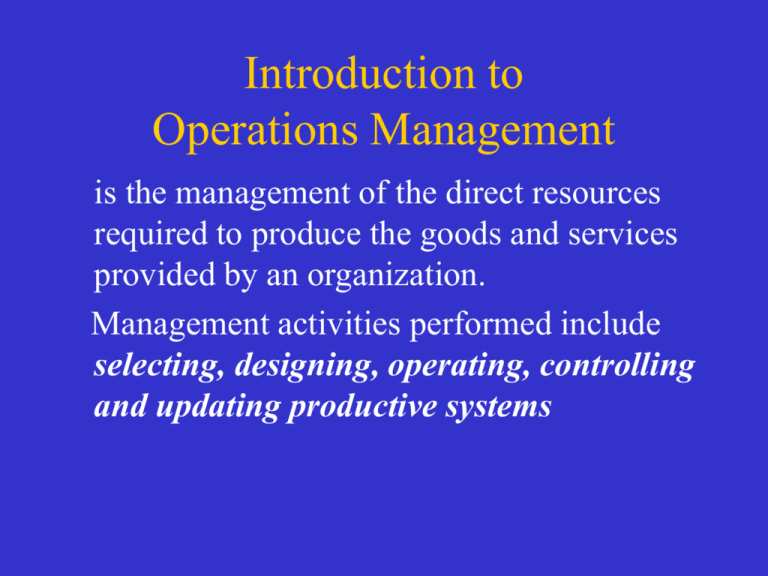
Introduction to Operations Management is the management of the direct resources required to produce the goods and services provided by an organization. Management activities performed include selecting, designing, operating, controlling and updating productive systems Types of Decisions 1. Strategic or long-range decisions 2. Tactical or medium- range decisions 3. Operational planning and control or shortrange decisions Questions Raised At Strategic Level: 1. How well we make the product? 2. Where do we locate facilities? 3. How much capacity is needed? and 4. When should capacity be added? At Tactical Level: 1. How many workers do we need? 2. When do we need them? 3. Is overtime needed or perhaps an additional shift? 4. When to deliver material? and 5. Is a finished goods inventory needed? At Operational Level: 1. Jobs to be done today or this week? 2. To whom tasks are assigned? and 3. Which jobs have priority? Role of OM Within an Organization Marketplace Corporate Strategy Marketing strategy Operations strategy Finance strategy The Transformation Process Inputs Customers/or materials Transformation Transformation process Process Outputs Goods & Services Types of Transformation • • • • • • Physical, as in manufacturing Locational, as in transportation Exchange, as in retailing Storage, as in warehousing Physiological, as in healthcare Informational, as in telecommunications. OM Contributions to Society 1. Higher Standard of Living 2. Better Quality Goods & Services 3. Concern for the Environment 4. Improved working conditions Value chain Trend toward having the transformation process work more closely with suppliers and customers alike is often referred to as a product’s value chain. Definition : All steps that actually add value to the product without distinguishing where they are added. This concept attempts to eliminate all nonvalue added steps(steps such as inspections and inventory), and results in a higher degree of dependence among the value added functions that are linked to the chain. Societal Development Vs. Mode and Technology of production Complex Sophisticated Societal Development Service – Information Age ? (Evolving) Agrarian stage,Craftsmanship Industrial Age (200 years old) (Lasted 100,000 years) Simple Primitive Stone Age,Bronze Age (Lasted over 500,000 years) Few Workers Mode of Production Labor-Intensive Technology of production Many Workers Capital-Intensive Line and staff jobs in operational Management Service Industries Organizational level Manufacturing industries Upper Vice president of manufacturing Regional manager of manufacturing Middle Plant manager Program Manager Vice-president of Operations(airline) Chief administrator (hospital) Store Manager(dept store) Facilities Manager (wholesale distributor) Lower Department supervisor Branch Manager (bank) Department supervisor Foreman (insurance company) Assistant Manager Crew chief Production controller Materials Manager Quality Manager Purchasing agent Work methods analyst Process Engineer Systems and procedures analyst Purchasing agent Inspector Dietician (hospital) Customer service manager Major Responsibilities of OM Managers 1. To estimate the demand for the products and services the company sells, 2. To produce these products and services efficiently, i.e. at the lowest cost possible, 3. To produce these products and services with a reasonable level of quality, and 4. To produce them cleanly, i.e. with minimum harm to the environment Models A model is an approximate representation of reality. Two Types of Models: 1. Physical Models : a) Iconic --- looks like the real system b) Analog --- acts like the real system. 2. Symbolic Models: a) Verbal --- using language to model thought, b) Mathematical --- using Math. to model reality Mathematical Models Math Models differ in four respects : 1 ) Purpose ----------------a) descriptive, b) optimization. 2 ) Mode -------------------a) analytic, b) numeric. 3 ) Randomness ---------- a) deterministic, b) probabilistic. 4 ) Generality ------------- a) applicable to one system. b) transferable to other systems. Challenges Facing OM Managers • Effectively consolidating the operations resulting from mergers & acquisition, • Developing flexible supply chain to enable mass customization of products and services, • Managing global suppliers, production, and distribution networks, • Managing a diverse workforce, • Effective response to restructuring, reengineering, and downsizing, • Conforming to environmental constraints, ethical, standards, and governmental regulations, • Developing and integrating new process technology with existing one. Chapter 2 Operations Strategy & Competition Competitiveness refers to the firm’s position in the marketplace. Operations Strategy refers to how the operations management function contributes to the firm’s ability to achieve its competitive advantage in the marketplace. Operations Strategies are developed from the competitive priorities of an organization which include: 1. Low cost, 2. High quality, 3. Fast delivery, 4. Flexibility, and 5. Service. Operations Strategy is thus concerned with a long-term plan in order to determine how to best utilize the major resources of the firm so that there is a high degree of compatibility between these resources and the firm’s long -term corporate strategy. Planning Issues Major long term issues include: 1. How big do we make the facilities? Plant size 2. Where do we locate them? location 3. What type of processes or technologies do we install to make the products? Process Tactical issues include: 1. Workforce size, 2. Material requirement. Operational issues include: 1. Daily worker scheduling, 2. Jobs & equipment, 3. Process management, 4. Inventory management Administrative process Strategic – Level Feed Back Tactical or Translators Level Operational Level Slack Or Information Trends Affecting Operations Strategy 1. Globalization: new opportunities and hyper-competition 2. Technology: connectivity, speed, and intangibility. Time Line for Operations Strategies c o m p e t i t i v e priority cost quality delivery flexibility Service 1950’s 1960’s 1970’s cost min. Manufacturing based Technology 1980’s 1990’s value max. info. based Order-Qualifiers: Minimum characteristics of a firm or its products to be considered as a source of purchase. Order-Winners: Characteristics of a firm that distinguish it from its competition so that it is selected as the source of purchase. Customer Activity Cycle (CAC) 1. Prepurchase: here activities focus on being responsive to customer inquires and the ability to demonstrate technical expertise, 2. Purchase: here activities center around the actual sale and delivery of the product and collecting payment, 3. Postpurchase: here activities include after sales support and product warranties. New Product and Service Development, and Process Selection Categories of new products: 1. Incremental or Derivative Products: products with least amount of innovation. These products are often cost-reduced versions of existing products or with some added minor features, e.g. waterproof Walkman CD player. 2. Next Generation or Platform Products: these products provide a broad base for a product family that can be leveraged over several years requiring more resource than incremental products, e.g. major model changeovers in the auto industry. 3. Breakthrough or Radical Products: these products require substantial product design and process change, e.g. first TV, cellular phone, etc. The New Product Development Process 1. Idea generation 2. Concept Development or initial design & analysis of customer requirements and market demand. 3. Quality function Deployment (QFD) translating customer requirements into engineering specifications. E.g. House of Quality on page 60. 4. Design for Manufacturability: material choices, process selection, efficiency, quality and safety consideration all needed to mass produce the product. Types of Processes in Manufacturing 1. Project: process that focuses on making one-of-a-kind products, e.g. producing a movie 2. Intermittent: process that produces products in small lot sizes: a) Job Shop – process where a specific quantity, generally small, of a product is produced only once, e.g. printing programs for a concert, b) Batch – a process that produces the same item again and again, usually in specified lot sizes, e.g. McDonald’s making hamburgers, lot size 12. 3. Line - Flow: continuous process that produces high volume, highly standardized products: a) Assembly Line: manufacture individual discrete products such as cars, b) Continuous: operates 24 hours/day, e.g. refining sugar or oil. See Exhibit 3.9 page 58. Categories of New Service 1. Window Dressing Services: low 2. degree of content and delivery changes. Breadth-of-offering Services: high content change, low delivery change. 3. Revolutionary Services: high content and delivery changes. 4. Channel Development Services: low content change, high delivery change Customer Contact Approach Service processes are distinguished by the degree of customer contact with the service system during the rendering of the service; thus we have high contact systems such as healthcare and low contact systems such as mailing a letter to someone. See service System Design Matrix on page 73 Types of Service organization 1. Facilities-based Services: services that require the customer to go to the service facility, 2. Field-based Services: services that can be performed at the customer’s location. Delivery Approaches 1. The Production Line Approach 2. The Customer Involvement Approach 3. The Personal Attention Approach Supplement PROJECT MANAGEMENT Supplement to Chp. 3: Project Management • A project is a statement or proposal of something to be done. Projects have a series of related jobs directed towards the achievement of a goal and requiring a significant amount of time to perform. • Project management involves planning, directing and controlling resources: people, capital, equipment, and material to meet the technical, cost, and time constraints of the project. Work Breakdown Structure • Program is made up of interrelated projects, each is often contracted by another organization. It is the highest order of complexity and may take years to complete. • Project is similar to a program but is less complex and shorter in duration. • Task is a subdivision of a project, and usually is completed in several months and performed by one organization. • Subtask is subdivision of a task. • Work package is a group of activities combined to be assignable to a single organizational unit. Organizational Considerations in Project Management • Role of the project manager: multidisciplinary, wide variety of skills, collaborative culture, social, and technical skills. • High Performance project teams: the necessary factors for the creation of a successful project team are: 1. Peoplerelated factors—good communications, involvement, resolve conflict, mutual trust and commitment to project objectives, 2. Leadership factors—ability to organize, direct, facilitate group decision making, and resolve problems, 3. Task related factors—ability to produce results within budget and on time, ability to innovate and to change, 4. Organizational factors— climate, authority structure, policies, procedures, regulations, values and economic conditions. ACTIVITIES OF OM • The overall manufacturing system. • Production engineering. • Computerized design, process planning, production planning and control and prove the efficiency and effectiveness of production engineering and manufacturing methods which in many high-technology and large-scale mass-production or processing plants have largely replaced traditional and mainly manual techniques. • Manufacturing. • Quality management. • Planned maintenance. • Inventory control. • Distribution. An itegrated operations system The overall management system The overall manufacturing system is the process of transforming materials and information into goods for the satisfaction of human needs. PRODUCTION ENGINEERING Production engineering is the generic term which covers all activities concerned with specifying, planning and controlling manufacturing processes. The main production engineering activities are: Process planning Process planning determines how the product or part should be manufactured by referring to component and assembly drawings and manufacturing reference data, and specifications produced at the design stage. Production planning. Production planning analyses sales forecasts and orders and decides on the manufacturing resources (capacity, materials and labor) required to meet the current and anticipated demand. Production planning involves capacity and aggregate planning, which aim to match the level of production to the level of demand. Aggregate planning Aggregate planning aims to ensure that capacity is available to meet demand at minimum cost. Production control Production control schedules production, loads the shops and monitors progress to ensure that production programs are achieved. Scheduling Scheduling involves: • Sequencing – determining the order in which jobs will be completed at each stage in the program; • Allocating the start and finishing time for each order; • Resource allocation – assessing labour and material requirements and their availability. Scheduling The approach adopted will be influences by the extend to which the company is making to order (responding to customer orders) or making to stock (anticipating future orders). Scheduling techniques • Material requirements planning, in which the known customer requirement for the final product is exploded to produce lists of parts and components required to make it. These known requirements are compared with available inventories to determine net requirements, which are then scheduled within available capacity. • Forward scheduling, which involves setting out activity timings from a given start date to achieve a defined completion date. This is usually computerized, although bar or Gantt charts are still maintained manually in some organizations. Scheduling techniques • Reverse scheduling, as used in make-to-order situations, involves subtracting activity timings from the due date for delivery and representing them on computerized schedules or Gantt charts. • Network analysis, which is used in complex projects to schedule various interrelated and interdependent activities • Line of balance, a technique used in batch production to calculate the quantities of the parts or components of the final product which must be completed by an intermediate date to ensure the final delivery schedule is met. Scheduling The output of the scheduling process is a master production schedule which sets out when the major operations required for each expected item of demand are to be undertaken. Master production scheduling aims to balance production possibilities with sales requirements. Shop loading. Shop loading takes the master schedule and verifies labor availability, prepares detailed programs and assigns the work to a machine or an operator. Shop loading will be related to the capacity available. Progress control. Progress control monitors the progress of orders through the shops against the master production schedule and delivery requirements so that corrective action can be taken to overcome delays, shortages and bottlenecks. Material control. Material control works from the master production schedule and, using materials requirements (MRP) and inventory control techniques, it: • Verifies material requirements • Requisition materials from buying and stores; • Receives and stores materials and bought in parts; • Identifies surplus stock and takes action to reduce it. The Role of Technology in Operations Technology impacts operational performance. It makes possible for the company to compete and excel on several dimensions simultaneously. Technology in Manufacturing includes the following: 1. Automation, 2. Machining Centers, 3. Numerically Controlled Machines(NC), 4. Industrial Robots, 5. CAD/CAM, 6. FMS, 7. CIM, 8. Islands of automation, 9. Information Technology, 10. ERP, 11. SCM, 12. NPD, 13. CRM MANUFACTURING SYSTEMS. • job, batch and flow production systems • the use of computer numerically controlled machine tools • flexible manufacturing systems (FMS) • the use of group technology • cellular manufacturing • the use of robots • computer-integrated manufacturing QUALITY MANAGEMENT Quality management activities aim to ensure that the high standards of product quality and service expected by customers are created and maintained. Quality management activities comprise: • quality control, quality assurance and total quality control systems • total quality management (TQM) systems INVENTORY CONTROL ACTIVITIES Inventory control activities aim to ensure that the optimum amount of inventory or stock is held by a company so that its internal and external demand requirements are met economically. Included are: • overall approaches to inventory control • the use of materials requirement planning (MRPI) and manufacturing resource planning (MRPII) systems • make or buy decisions. PLANNED MAINTENANCE ACTIVITIES • Planned maintenance draws up in advance and implement plant, equipment and building maintenance programs to ensure that they operate or remain trouble free for a predetermined period. DISTRIBUTION ACTIVITIES Distribution activities are concerned with storing completed products in warehouses, depots and stores and the dispatching and delivery of products to customers. Those concerned with physical distribution management and distribution planning. PROJECT MANAGEMENT ACTIVITIES. Project management activities are concerned with the planning, supervision and control of large-scale engineering or construction projects. Manufacturing Systems Manufacturing is the process of transforming materials and information into goods for the satisfaction of human needs. MANUFACTURING AS A PROCESS Manufacturing can be subdivided into: • • manufacturing processes, which alter the form, shape and/or physical properties of a given material; • • manufacturing equipment, which is used to perform manufacturing processes; • • manufacturing systems, which are combinations of manufacturing equipment and humans bound by a common material and information flow; • • design and manufacturing interfaces, which are the links between the drawing, sketch, computer-assisted design (CAD) file or other ways of communicating the features and characteristics of the product or subassembly to be manufactured. MANUFACTURING DECISIONS • • • • Manufacturing decisions are concerned with the following four attributes: 1. Cost 2. Time 3. Flexibility 4. Quality Cost • • • • • • • Equipment Materials Labour Energy Maintenance Training Overhead and capital Time The speed with which a manufacturing system can respond to change and how quickly a product can be produced by the system (the production rate). Flexibility The ability to meet the demands of a diversified and changing customer base in a global market. Flexibility is required in the following areas. Flexibility • Machine flexibility. The ease of making changes required to produce a given set of part types. • Process flexibility. The ability to produce a given set of part types, possibly using different materials in different ways. • Product flexibility. The ability to change over to produce new products economically and quickly. • Routing flexibility. The ability to handle breakdowns and to continue producing a given set of part types. Flexibility • Volume flexibility. The ability to operate profitably at different production volumes. • Expansion flexibility. The ability to expand the system easily and in a modular fashion. • Operation flexibility. The ability to interchange ordering of several operations for each part type. • Production flexibility. The universe of part types the manufacturing system can produce. Quality How well the production process meets the design specifications related to the different features and properties of the product. Production Planning and Control Systems (PPCS) Production planning and control systems (PPCS) use computers to determine the optimum levels of manufacturing resources required to meet demand forecasts, prepare production program, schedule production to meet those program and monitor operational activities to ensure that customer demand is satisfied while resources are used effectively. THE BASIC PPCS MODEL PPCS ACTIVITIES • process planning • demand forecasting • aggregate planning, which includes capacity planning • master production scheduling • scheduling • monitoring and control. Process planning determines • • • • • • the manufacturing processes involved; the machine tools required to execute these processes; the tools and fixture required at each stage of processing; the number and depth of passes in a machining operation; the feeds and speeds appropriate to each operation; the type of finishing processes necessary to achieve the specified tolerances and surface quality. Demand forecasting Demand forecasting leads to the planning of demand for a particular product. The planning is done in terms of specific modes, styles and sizes of the product range. A variety of forecasting methods are used and the result is input into the medium-term planning stage known as aggregate planning. Aggregate planning Aggregate planning Is therefore largely concerned with capacity planning deciding the capacity required in the system and developing and implementing a strategy for the use of given resources to meet demand fluctuations Rough-cut capacity planning (RCCP) Rough-cut capacity planning (RCCP) analyze the feasibility of fulfilling a particular production program as required by the demand forecast. RCCP provides a basis for producing the master production schedule. Master production scheduling It is a breakdown of the aggregate plan showing when the major operations required for each expected item of demand are to be undertaken. Master production scheduling aims to balance production possibilities with sales requirements. Scheduling • • • • The detailed scheduling of work and the allocation of labour and material requirements is carried out by one or other of the following computer-based techniques: Material requirement planning Manufacturing resource planning Optimized production technology Just-in-time (JIT) Monitoring and control Production monitoring can be carried out by means of computer control systems, the aim being to keep machines as fully utilized as possible. BENEFITS • better planning of shop and purchase orders resulting in on-time deliveries, reduced manufacturing lead times and fewer shortages; • improved control of shop orders resulting in shorter queues, reduced work-in-progress, less idle time and fewer bottlenecks; and • monitoring and control of machine tools and production processes resulting in better utilization, improved quality and reduced costs. Process Measurement & Analysis Process analysis is conducted to identify and select the best or most efficient process, i.e. process at lowest cost possible. In order to accomplish this measurement of process performance is needed. Types of Performance: Capacity Utilization, 1. Productivity, 2. Capacity, 3. Quality, 4. Speed of Delivery, 5. Process Velocity, 6. Flexibility 7. Benchmarking. Commonly Used Terms in Process Analysis • Hybrid Process: Multistage process that consists of more than one type of process. •Make-to-Stock System: process for making highly standardized products for finished goods inventory. *Make –to-Order System: process for making customized products based on customer’s order. •Modularization: use of standard components and subassemblies to produce customized products Tightness, Dependence & Bottlenecks These conditions occur as a result of the relationship between the various stages in a process. Tightness: it results from a high degree of dependence between stages as is the case in assembly line production, lack of buffer inventory causes that. The more buffer the less the dependence among stages and hence less tightness in the production line. Bottlenecks: it is caused by capacity variation in multistage operations. The stage with lowest capacity is referred to as the bottleneck in the entire operation. Productivity Definition: It is the efficient use of resources: labor, capital, land, materials, energy, information, etc. in the production of goods and services. It can also be defined as the relationship between results and the time it takes to accomplish them. Common Misunderstandings About Productivity 1. It is not only labor efficiency, 2. It is not possible to judge performance simply by output, 3. Confusion about productivity and profitability, 4. The belief that cost-cutting always improves productivity, 5. That it can only be applied to production. Examples of Productivity Measurement 1. Partial measure (single factor) Output / Labor, Output / Capital 2. Multi-factor measure Output Capital + Labor 3. Total measure Output All inputs Examples of Partial Measures Business Measure Restaurant……………..Customers / labor hour Retail Store…………….Sales / square foot Chicken Farm…………..lb. Of meat / lb of feed Utility Plant…………….Kw / ton of coal Paper Mill………………tons of paper / cord of wood Capacity Capacity: is the output capability of a process in a specified period of time. Design Capacity is the output the plant is designed to achieve and Actual Capacity or Output is the actual amount the plant is producing. Capacity Utilization: is the percent capacity used: Actual Output Design Capacity Quality, Speed of Delivery, and Process Velocity Quality: quality can be measured by: defective rate, number and frequency of kudos/ or complaints (customer satisfaction), or by amount of toxic waste the company is releasing into the environment. Speed of Delivery: is measured from the time an order is placed to the time it is shipped to the customer.The shorter the time the better. Also variability of the speed of delivery is an important measure of performance. Process Velocity: Total Throughput time Value-added time COMPUTERIZED DESIGN, PROCESS PLANNING, PRODUCTION PLANNING AND CONTROL, AND MANUFACTURING SYSTEMS. • Computer-aided design (CAD) • Computer-aided design (CAD), uses computers to assist in the production of designs, drawings and data for use in manufacture. • Computer-aided manufacture (CAM) • Computer-aided manufacture uses computers to support manufacturing processes, especially those consisting of computer numerically controlled (CNC) machines, robots and automated material handling systems. CADCAM • CADCAM, also known as computer-aided engineering (CAE), links product design and manufacturing through integrated CAD and CAM computer systems. For example, a CADCAM system in the electronic industry, where it is most often found, might consist of CAD work stations, in which integrated circuits and printed circuit boards are designed, which are linked to a processor with a database that provides output to drive computer numerically controlled (CNC) machines. CIM • Computer-integrated manufacture (CIM), uses information technology to integrate the various processes which together comprise the total manufacturing process. The computerized systems used in a full CIM system will include CAD and CAM as described previously. A CADCAM system is sometimes regarded as being synonymous with CIM. A full CIM system, however, will also incorporate computer-aided process planning (CAPP) and computerized production planning and control (CPPC). CAPP • Computer-aided process planning (CAPP) uses computers to produce process plans for production or parts. It can automatically develop these and routings from the outputs of CAD. It leans heavily on the parts classification and coding aspects of grouping technology (GT). CAPP • There are two approaches to CAPP: • Variant process planning, in which process plans are stored in digital form thus allowing the planner to select and modify appropriate plans as needed • Generative process planning, in which descriptions of the parts, the manufacturing process, the machine tools and the tooling are entered into the computing system which then develops a new process plan. It makes no reference to prior plans and therefore requires more complex decision sequences than variant process planning. CPPC • • The overall production planning and control system (PPCS). A choice of planning and scheduling systems: – – – – Material requirements planning (MRPI) Manufacturing resource planning (MRPII) Optimized production technology (OPT) Just-in-time systems (JIT) CPPC • • Process control systems. Layout planning which determines the physical disposition of departments and selection on a site and location plant, machinery and equipment in each area. Much of the work of planning layouts can be computerized although techniques such as cross charts and relationship charts are also used manually. Materials Requirement Planning (MRPI) Materials requirement planning (MRPI) is a computerized production scheduling system which takes the forward schedule of final product requirements (the master production schedule) and translates it progressively into the numbers of subassemblies, components and raw materials required at each stage of the manufacturing cycle. AIMS • determine for final products what should be produced at what time; • calculate the required production of sub-assemblies; • determine the requirement for materials based on an up-todate bill of materials (BOM); • calculate inventories, work-in-progress, batch sizes and manufacturing and packaging lead times; and • generally control inventory by ordering bought-in components and raw materials in relation to the orders received or forecast rather than the more usual practice of ordering from stock-level indicators. MRPI system provides information • • • • Gross requirements. Scheduled receipts Projected available balance Planned order release BENEFITS The benefits of MRPI are that a detailed forecast of the inventory position is produced period by period which, together with the planned order release entries, enables future production to be planned more accurately and better control to be maintained of inventory. Manufacturing Resource Planning (MRPII) MRPII is a computer-based system designed to manage all the resources of a manufacturing organization. It acts as a planning and scheduling system, linking manufacturing with the sales and finance departments and providing tools for joint decision-making among all three departments. ESSENTIAL ELEMENTS OF MRPII • • • • • • • • • • The demand forecast Production planning Resource planning Rough-cut capacity planning The master production schedule Bills of materials Detailed material and capacity plans Shop- and purchase-order release Shopfloor control Purchase and inventory control MRP II BENEFITS • MRPII is a demand-driven system which integrates planning and control systems. It takes account of capacity requirements and constraints and enables decisions to be made at each stage of the manufacturing process in a coordinated fashion. • MRPII also provides a systems capability which can simulate future possibilities by processing multiple sets of data to model alternative manufacturing environments. ERP Enterprise Resource Planning Systems : fully integrated software system that links all of the major functional areas in the organization. ERP systems are an outgrowth of Material Requirements Planning (MRP) systems. Benefits of ERP Systems : Provide competitive advantage— the benefits can take many forms: 1. Reduction of number of errors because a common database is used, 2. Faster customer response times, and 3. Better overall communications within the organization. Failure of ERP systems is due to: lack of top management commitment, lack of adequate resource, lack of proper training, and lack of communication. Benchmarking Defined: is the continuous process of measuring the desired features of products and services, and practices against world class standards or reputable companies considered as tops in that industry. Goods & Services, Business Processes, and Performance Measures can be benchmarked. Key Steps in Benchmarking 1. Planning 2. Analysis 3. Integration 4. Action 5. maturity Types of Benchmarking 1. Internal 2. Competitive 3. Functional 4. Generic Reengineering It is the process of rethinking and restructuring an organization. Characteristics of a Reengineered Process: 1. Several jobs combined into one 2. Workers make decisions 3. The steps in the process are performed in a natural order 4. Processes have multiple versions 5. Works is performed where it makes most sense


